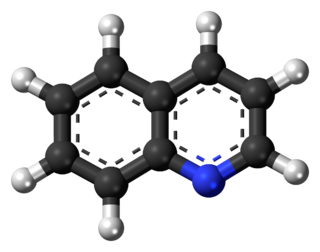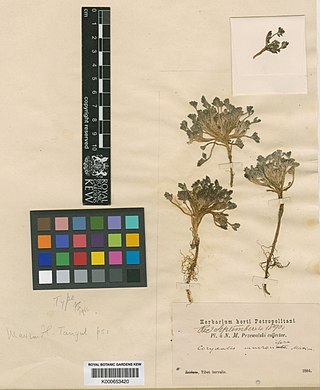
Alkaloids are a class of basic, naturally occurring organic compounds that contain at least one nitrogen atom. This group also includes some related compounds with neutral and even weakly acidic properties. Some synthetic compounds of similar structure may also be termed alkaloids. In addition to carbon, hydrogen and nitrogen, alkaloids may also contain oxygen, sulfur and, more rarely, other elements such as chlorine, bromine, and phosphorus.

Quinoline is a heterocyclic aromatic organic compound with the chemical formula C9H7N. It is a colorless hygroscopic liquid with a strong odor. Aged samples, especially if exposed to light, become yellow and later brown. Quinoline is only slightly soluble in cold water but dissolves readily in hot water and most organic solvents. Quinoline itself has few applications, but many of its derivatives are useful in diverse applications. A prominent example is quinine, an alkaloid found in plants. Over 200 biologically active quinoline and quinazoline alkaloids are identified. 4-Hydroxy-2-alkylquinolines (HAQs) are involved in antibiotic resistance.

β-Carboline (9H-pyrido[3,4-b]indole) represents the basic chemical structure for more than one hundred alkaloids and synthetic compounds. The effects of these substances depend on their respective substituent. Natural β-carbolines primarily influence brain functions but can also exhibit antioxidant effects. Synthetically designed β-carboline derivatives have recently been shown to have neuroprotective, cognitive enhancing and anti-cancer properties.
Neuraminidase inhibitors (NAIs) are a class of drugs which block the neuraminidase enzyme. They are a commonly used antiviral drug type against influenza. Viral neuraminidases are essential for influenza reproduction, facilitating viral budding from the host cell. Oseltamivir (Tamiflu), zanamivir (Relenza), laninamivir (Inavir), and peramivir belong to this class. Unlike the M2 inhibitors, which work only against the influenza A virus, NAIs act against both influenza A and influenza B.

Fumaria officinalis, the common fumitory, drug fumitory or earth smoke, is a herbaceous annual flowering plant in the poppy family Papaveraceae. It is the most common species of the genus Fumaria in Western and Central Europe.

Aporphine is an alkaloid with the chemical formula C17H17N. The IUPAC name of aporphine is 6-methyl-5,6,6a,7-tetrahydro-4H-dibenzo[de,g]quinoline. It is the core chemical substructure of the aporphine alkaloids, a subclass of quinoline alkaloids. It can exist in either of two enantiomeric forms, (R)-aporphine and (S)-aporphine.

Bulbocapnine is an alkaloid found in Corydalis and Dicentra, genera of the plant family Fumariaceae which have caused the fatal poisoning of sheep and cattle. It has been shown to act as an acetylcholinesterase inhibitor, and inhibits biosynthesis of dopamine via inhibition of the enzyme tyrosine hydroxylase. Like apomorphine, it is reported to be an inhibitor of amyloid beta protein (Aβ) fiber formation, whose presence is a hallmark of Alzheimer's disease (AD). Bulbocapnine is thus a potential therapeutic under the amyloid hypothesis. According to the Dorlands Medical Dictionary, it "inhibits the reflex and motor activities of striated muscle. It has been used in the treatment of muscular tremors and vestibular nystagmus".

Tetrahydroisoquinoline (TIQ or THIQ) is an organic compound with the chemical formula C9H11N. Classified as a secondary amine, it is derived from isoquinoline by hydrogenation. It is a colorless viscous liquid that is miscible with most organic solvents. The tetrahydroisoquinoline skeleton is encountered in a number of bioactive compounds and drugs.

Glaucine is an aporphine alkaloid found in several different plant species in the family Papaveraceae such as Glaucium flavum, Glaucium oxylobum and Corydalis yanhusuo, and in other plants like Croton lechleri in the family Euphorbiaceae.

Tetrahydropalmatine (THP) is an isoquinoline alkaloid found in several different plant species, mainly in the genus Corydalis, but also in other plants such as Stephania rotunda. These plants have traditional uses in Chinese herbal medicine. The pharmaceutical industry has synthetically produced the more potent enantiomer Levo-tetrahydropalmatine (Levo-THP), which has been marketed worldwide under different brand names as an alternative to anxiolytic and sedative drugs of the benzodiazepine group and analgesics such as opiates. It is also sold as a dietary supplement.

Conessine is a steroid alkaloid found in a number of plant species from the family Apocynaceae, including Holarrhena floribunda, Holarrhena antidysenterica and Funtumia elastica. It acts as a histamine antagonist, selective for the H3 subtype (with an affinity of pKi = 8.27; Ki = ~5 nM). It was also found to have long CNS clearance times, high blood–brain barrier penetration and high affinity for the adrenergic receptors.

(S)-Canadine, also known as (S)-tetrahydroberberine and xanthopuccine, is a benzylisoquinoline alkaloid (BIA), of the protoberberine structural subgroup, and is present in many plants from the family Papaveraceae, such as Corydalis yanhusuo and C. turtschaninovii.

Nantenine is an alkaloid found in the plant Nandina domestica as well as some Corydalis species. It is an antagonist of both the α1-adrenergic receptor and the serotonin 5-HT2A receptor, and blocks both the behavioral and physiological effects of MDMA in animals.

Indole is an aromatic heterocyclic organic compound with the formula C8H7N. It has a bicyclic structure, consisting of a six-membered benzene ring fused to a five-membered pyrrole ring. Indole is widely distributed in the natural environment and can be produced by a variety of bacteria. As an intercellular signal molecule, indole regulates various aspects of bacterial physiology, including spore formation, plasmid stability, resistance to drugs, biofilm formation, and virulence. The amino acid tryptophan is an indole derivative and the precursor of the neurotransmitter serotonin.

Panicudine (6-hydroxy-11-deoxy-13-dehydrohetisane) is a C20-diterpene alkaloid of the hetisine type, first isolated from Aconitum paniculatum. It has empirical formula C20H25NO3 and a melting point of 249–250 °C. The structure was determined to be a hetisine type diterpene by noting infrared spectrum absorption bands of 3405 cm−1 (OH), 1718 (C=O), and 1650 (C=C), a proton magnetic resonance spectrum with "secondary hydroxy (4.02 ppm, m, 1H, W1/2 = 10 Hz), exomethylene (4.87 and 4.76 ppm, br.s, 1H each), and tertiary methyl (1.29 ppm, s, 3H) groups and the absence of N-methyl, N-ethyl, and methoxy groups." Additional ultraviolet spectrum and carbon-13 NMR data, confirmed by high resolution mass spectrometry, completed the determination of the structure.

(S)-Cheilanthifoline is a benzylisoquinoline alkaloid (BIA) which has been isolated from Corydalis dubia and Argemone mexicana. (S)-Cheilanthifoline is metabolically derived from (S)-reticuline, a pivotal intermediate in the biosynthesis of numerous BIAs. (S)-Cheilanthifoline is the immediate precursor of the BIA (S)-stylopine, which is the precursor for the alkaloids protopine and sanguinarine.
Corydalis yanhusuo is a plant species in the genus Corydalis. The Chinese name for Corydalis yanhusuo is yan hu suo. The Japanese common name is engosaku (エンゴサク) and the Korean common name is hyeonhosaek (현호색). English common names include yanhusuo, corydalis, and Asian corydalis. The tuber of this plant, frequently mislabeled as the root, is an important therapeutic agent in traditional Chinese medicine. It is native to high-altitude grasslands across China including in the provinces of Anhui, Henan, Hubei, Hunan, Jiangsu, and Zhejiang, but is more widely cultivated.
Tuticorin Raghavachari Govindachari FNA, FASc (1915–2001), popularly known as TRG, was an Indian natural product chemist, academic, institution builder and the principal of Presidency College, Chennai. He was known for his studies on the synthesis of isoquinolines and phenanthridines and his contributions in elucidating the structure of several plant constituents. He was an elected fellow of the Indian Academy of Sciences and the Indian National Science Academy and was the nominator of Robert Burns Woodward who won the 1965 Nobel Prize in Chemistry. The Council of Scientific and Industrial Research, the apex agency of the Government of India for scientific research, awarded him the Shanti Swarup Bhatnagar Prize for Science and Technology, one of the highest Indian science awards, in 1960, for his contributions to chemical sciences, making him the first recipient of the award in the chemical sciences category.

Aporphine alkaloids are naturally occurring chemical compounds from the group of alkaloids. After the benzylisoquinoline alkaloids they are the second largest group of isoquinoline alkaloids.

Corydalis mucronifera is a plant which does not have a common name as it is quite rare in nature. This plant has also previously been recorded as Corydalis boweri. Being as rare as it is, it has only been found in two regions: China and Tibet. The range where the plant can be found is small as it is only found near rocky beaches or high mountain ranges at altitudes between 4200 and 5300 meters. Corydalis mucronifera is small in size and displays a variety of colors: purple, yellow, white, and cream. The plant has similar structures to other plants found in Europe and North America as it displays a racemose corymb. Due to its herbal properties, it is currently being studied in medicine for its inhibitory properties; these properties are focused in studies regarding neurodegenerative disorders.
















